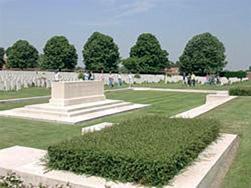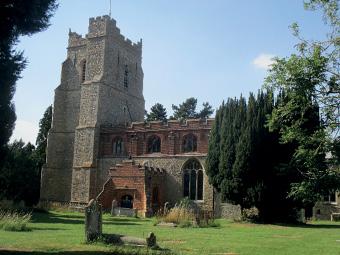
9 minute read
Pulpit: The Boys Enlisted into the Army
Stories of young men who joined the army during the first world war.
My grandson Tom aged 16 by the grave of a 16 year old soldier. High Easter is a village some ten miles to the north of Chelmsford. It is a lovely village with a fine church dedicated to the Virgin Mary and large a churchyard. In 2011, the population was 754. I went to visit the village and had a look around the graves and headstones. To my surprise, even to my shock, I read the headstone of one soldier, named as Private A. Staines, of the Essex Regiment who died in 1915 at the age of 16. I was really shocked.
Advertisement
The gravestone is difficult to read, but this is what it declared, right.
I learned that he was the son of William and Sarah Mary Staines, of Chalks Cottage, High Easter. He had less than 6 months qualifying service and did not get a War Gratuity as he had no overseas service.
I immediately recruited my oldest grandson Tom, also aged 16 (above) and dragged him to High Easter to pose by this other 16-year-old’s gravestone to emphasise what a 16-year-old looks like in normal times.
But how could a 16-year-old have been killed in a soldier’s uniform? I was just a bit fuming! Well, then I did some research, and all is not what it appeared to me to be at first sight. I was helped by one of the proprietors of Lodge Brothers Coaches, just down the road from the church. I got lucky! Mr Lodge went out of his way to be helpful, even leaving work to go home and fetch me a book about the village in the 20th century. He photocopied some pages, and this was a great discovery for me. The vicar of the parish, back in 1914, wrote a regular report on what was happening in the village and also reported on those villagers who were involved with the war. In April, 1915, the vicar reported as follows:
April. The War. It is with much sorrow that we think of the death of Arthur Staines, one of the recent recruits. He enlisted last November and joined the 5th Batt. of the Essex Regt quartered at Peterborough. There he was taken ill on Feb 4th and was moved to the First Eastern General Hospital at Cambridge, where he died on Feb 22nd cerebrospinal meningitis. (His burial took place at High Easter where the register records Feb 27th Arthur Staines 17) A. Staines 2894 Private Essex Regiment 22nd February 1915 Age 16
God took him
I was relieved that Arthur didn’t die in action, but even so, how did a 15-year-old manage to enlist at all?
I discovered that a man wishing to join the army could do so providing he passed certain physical tests and was willing to enlist for a number of years. The recruit had to be taller than 5 feet 3 inches and aged between 18 and 38 (although he could not be sent overseas until he was aged 19). At first, enlisting was not compulsory and as the war effort grew it became obvious that there was a need to introduce conscription. After a fairly unsuccessful recruitment scheme was introduced, known as the Derby Scheme, the Government introduced The Military Service Act on 27 January 1916. All voluntary enlistment was stopped. All British males were now deemed to have enlisted on 2 March 1916 – that is, they were conscripted – if they were aged between 19 and 41 and resided in Great Britain (excluding Ireland) and were unmarried or a widower on 2 November 1915. Conscripted men were no longer given a choice of which service, regiment or unit they joined, although if a man preferred the navy it got priority to take him. This act
was extended to married men, and the lower age dropped to 18, on 25 May 1916. It was clear that in 1915, under-age recruits did not have to prove their age, and they didn’t even have to prove their identity!
Although there are lots of new houses in High Easter, Chalks Cottage where Arthur Staines was born, is still there. (See above).
My research led me to read about many underage recruits. On the right you see the headstone of Private J. Condon of the Royal Irish Regiment who died aged 14. John Condon (1900 – 1915) was an Irish soldier born in Waterford, long believed to have been the youngest Allied soldier killed during the Great War, at the age of 14 years, as shown on his gravestone. It is now believed from a birth certificate, census, war diaries and other records that John Condon was 18 years old at the recorded date of his death and that the wrong individual is named on the grave in Poelkappele Cemetery, in Langemark, Belgium.
A somewhat happier outcome was to be enjoyed by Sidney George Lewis (1903 – 1969) who enlisted in the East Surrey Regiment in August 1915 at the age of twelve! He fought in the Battle of the Somme in 1916, then aged thirteen, in the 106th Machine Gun Company of the Machine Gun Corps. Lewis fought in the Battle of Delville Wood which saw some of the worst casualties on the Somme. He was sent home after his mother sent his birth certificate to the War Office and demanded his return. (Well done, mum!!) Lewis was awarded the Victory Medal and the British War Medal. He re-enlisted in 1918 and served with the army of occupation in Austria. He joined the police in Kingston upon Thames after the war and served in bomb disposal in World War II. Later, he ran a pub in Frant, East Sussex. He died in 1969. Although The Great War army recruiters often turned a blind eye to underage recruits, another factor may have been Lewis's mature appearance. He was a tall, heavily built boy, growing to 6 feet 2 inches (1.88 m) as an adult. The minimum height requirement of the British Army at the time was only 5 feet 3 inches (1.60 m).
According to the BBC documentary Teenage Tommies (first broadcast 2014), the British Army recruited 250,000 boys under eighteen during the Great War. This included Horace Iles who was shamed into joining up after being handed a white feather by a woman whilst at the tender age of fourteen. He died at the Battle of the Somme at the age of sixteen.
Amusing stories may be found among all this strangely dangerous behaviour by young boys. For example. George Maher (1903 – c.1999) was only thirteen when he lied to a recruiting officer by claiming he was eighteen and was allowed to join up with the 2nd Battalion King's Own Royal Lancaster Regiment. Maher was sent to the front lines and his actual age was not found out until he began crying during heavy shelling and was taken before an officer of his regiment to reveal his young age. George said he was then locked in a train with a number of other young boys who had all lied to join up as well. Maher said "The youngest was twelve years old. A little nuggety bloke he was, too. We joked that the other soldiers would need to lift him up to see over the trenches."
But it wasn’t just the British Army that found boys among the soldiers. The case of seven year-old Serbian Momčilo Gavrić (pictured right) is a shocking story indeed. In the beginning of August 1914, Austro-Hungarian soldiers of 42nd Croatian Home Guard Infantry Division maimed and hanged his father, mother, grandmother, his three sisters, and four of his brothers. His house was also set on fire. Momčilo survived because he was not at home when it happened—his father had sent him to his uncle earlier.

Poelkappele Cemetery

Boy soldiers from the Lancashire Regiment

Momčilo takes the salute
Left without family and without a home, Momčilo went to find the 6th Artillery Division of the Serbian army, which was near Gučevo at the time. Major Stevan Tucović, accepted Gavrić into his unit after hearing about what had happened, and assigned Miloš Mišović, a soldier in the unit, to be Gavrić's caretaker. The same evening, he took revenge by showing his unit the location of the Austro-Hungarian soldiers, and participated in the bombardment, as told by his son Branislav Gavrić in an interview.
At the age of 8, after the Battle of Cer, he was promoted to the rank of Corporal by the commander of his unit, and given a military uniform. He survived the war and died in Belgrade in 1993. There are memorials dedicated to him on the island of Korfu and in the Jadar Museum in Loznica. In 2014, a street in Loznica was named after him.
On 2 April 2015, the Serbian government decided to raise a monument in Belgrade dedicated to Gavrić.
A final example of this under-age story is that of fifteen-year-old Cyril Jose. He was a tin-miner's son from Cornwall. With the region suffering from heavy unemployment, the boy with a strong sense of adventure joined up. From his training camp he wrote an excited letter to his sister Ivy:
"Dearest Ivy, stand back. I've got my own rifle and bayonet. The bayonet's about 2ft long from hilt to end of point. Must feel a bit rummy to run into one of them in a charge. Not 'arf. Goodbye and God bless you, from your fit brother, Cyril."
Cyril survived the war but the bloodshed he witnessed in France turned him into a vehement opponent of militarism for the rest of his life. In one letter home he poured scorn on the British commander, Field Marshal Earl Haig. (pictured left) "What brains Earl Douglas must have. 'I attacked,' he boasted! Old women in England picturing Sir Doug in front of the British waves brandishing his sword at Johnny in the trenches... attack Johnny from 100 miles back. I'll get a job like that in the next war."
And through all the deception, injury, death, separation and hardship which war creates, here you see the Church of St. Mary in High Easter, standing calmly and witnessing to centuries of disaster and warfare, but reminding us that in the end, love is the answer, all kinds of expressions of love, from the many people who have made marriage vows to each other, the many babies that have been carried lovingly for baptism, and the loving farewells offered to many people buried in the churchyard.











